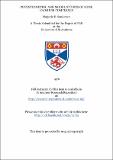Files in this item
Potentiometric and model studies of some Cadmium complexes
Item metadata
| dc.contributor.advisor | Williams, David R. | |
| dc.contributor.author | Sanderson, Marjorie D. | |
| dc.coverage.spatial | vi, 140 p. | en_US |
| dc.date.accessioned | 2018-06-28T13:39:12Z | |
| dc.date.available | 2018-06-28T13:39:12Z | |
| dc.date.issued | 1976 | |
| dc.identifier.uri | https://hdl.handle.net/10023/14715 | |
| dc.description.abstract | The Stability constants of some cadmium (II) ligand complexes have been measured by glass electrode potentiometry. These constants were used in computer model systems in order to assess the ligand's suitability as a cadmium sequestering agent in vivo. It is suggested that nitrogen and oxygen containing amino-acids complex zinc preferentially with respect to cadmium, and that the existing cadmium therapeutical, EDTA, is highly unspecific. Glutathionate is proposed as the most promising ligand for the treatment of cadmiumism. An investigation was undertaken to assess the reliability and accuracy of a solid state cadmium-ion selective electrode. A new system of metal buffers was introduced into the calibration but it was found impossible to obtain reproducible results with this electrode. The electrode was used in a study of the cadmium asparaginate and serinate systems and checked against a computer simulation. The best 'fit' was obtained from a value of mV/pCd far from the theoretical value of -29.586 and it was concluded that the glass electrode was the more reliable means of measuring titration data. The partition coefficient of the cadmium(II) glutathionate system was calculated for octanol/water as a model for cell membranes. This suggested a maximum of 2% of cadmium inside a cell being partitioned out by glutathionate and that ratios of ligand: metal greater than 1:1 would be the most efficient for complexing the metal. The Belousov-Zhabotinsky oscillating reaction was taken as a primitive model of biochemistry and the qualitative effect of introducing different materials to the system was noted. The computer program COMICS was modified for loading on to the St. Andrews IBM 560/44 computer and adapted to include three plotter routines. | en_US |
| dc.language.iso | en | en_US |
| dc.publisher | University of St Andrews | |
| dc.subject.lcc | QD181.C3S2 | |
| dc.subject.lcsh | Cadmium -- Analysis | |
| dc.title | Potentiometric and model studies of some Cadmium complexes | en_US |
| dc.type | Thesis | en_US |
| dc.contributor.sponsor | University of St Andrews | en_US |
| dc.type.qualificationlevel | Doctoral | en_US |
| dc.type.qualificationname | PhD Doctor of Philosophy | en_US |
| dc.publisher.institution | The University of St Andrews | en_US |
This item appears in the following Collection(s)
Items in the St Andrews Research Repository are protected by copyright, with all rights reserved, unless otherwise indicated.

